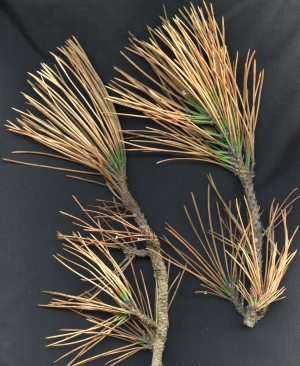Dothistroma Needle Blight of Pines
 Causal Agent
Causal Agent
Mycosphaerella pini (perfect), Dothistroma pini (imperfect)
Hosts: Over 30 species of pines, including Austrian, ponderosa, mugo, slash, Japanese
black, and loblolly pines.
Symptoms
Symptoms develop in the fall of the year in which the infection was initiated. Early
symptoms consist of yellow and tan spots, and water-soaked bands on the needles. The
bands and spots may turn brown to reddish brown and may be surrounded by yellow bands.
The tip of the needle beyond the red band eventually turns brown while the needle
base remains green. The dead portion of the needle may break off 
Control
Dothistroma needle blight is controlled mainly through the application of protective fungicides. Two applications are recommended, the first in mid-May to protect the previous seasons' needles and the second in mid-June to July to protect the current year needles. Depending on the size of the tree, it may be possible for a home owner to treat their own trees or they may need to contact a pesticide applicator. Products that contain copper will help control Dothistroma needle blight. Additionally, the grower should rake up and discard fallen needles.

